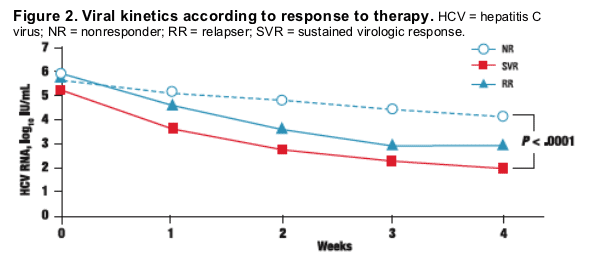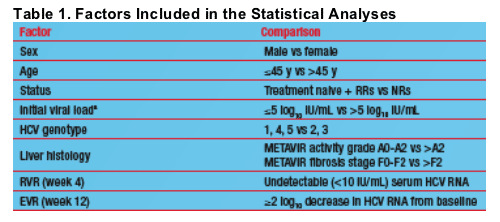 |
 |
 |
| |
Rapid Virological Response at Week 4 Is the Best Predictor of Treatment Outcome in Patients With Chronic Hepatitis C: A Multivariate Analysis
|
| |
| |
Reported by Jules Levin
AASLD, Nov 2-6, 2007, Boston, MA
Michelle Martinot-Peignoux,1 Sarah Maylin,1 Rami Moucari,2 Marie-Pierre Ripault,2 Nathalie Boyer,2 Nathalie Giuily,2 Corinne Castelnau,2 Tarik Asselah,2 Patrick Marcellin1,2
1INSERM U-773, Centre de Recherche Biomedicale Bichat-Beaujon CRB3, Universite Paris VII; 2Service d'Hepatologie, H˘pital Beaujon, Clichy, France
Conclusions
⋅ For treatment-naive patients, RVR (undetectable HCV RNA at week 4 of therapy) is the strongest independent factor for prediction of SVR
⋅ For patients who were NRs to previous therapy, high initial viral load (>5 log10 IU/mL) and absence of EVR (<2 log10 decrease in HCV RNA from baseline at week 12 of therapy) are the strongest predictors of non-SVR
⋅ Therefore, the following should be assessed during anti-HCV therapy

Abstract
Background: It is well established that HCV genotype and baseline HCV RNA are good predictors of sustained virological response (SVR) in selected patients included in clinical trials of pegylated interferon alfa (PEG-IFN) + ribavirin (RBV). Limited knowledge is available on predictors of SVR in the general population managed in routine clinical practice.
Methods: 408 patients consecutively treated with PEG-IFN _-2b + RBV, were studied (221 naives; 125 nonresponders (NRs); 62 relapsers (RRs). Patients with genotypes 1 or 4 and non-naive were treated 48 weeks and patients with genotypes 2 or 3 for 24 weeks (PEG-IFN 1.5 _g/kg/week; RIBA 800-1200 mg/day). Serum HCV RNA was measured at baseline, week 4, week 12, end
of treatment and 6 months after the end of treatment with the quantitative VERSANT HCV 3.0 Assay (bDNA) (Siemens). Samples below the limit of quantification were tested with the VERSANT HCV RNA Qualitative Assay (TMA) (Siemens). SVR was defined as undetectable serum HCV RNA by TMA at the end of 6-month post-treatment follow-up. The characteristics included in the logistic regression analysis were: baseline viral load (≦vs>400 - 103IU/ml), HCV genotype (1, 2, 3, 4, 5), gender, age (≦vs>45y), histology grade (A0-1≦vs>A2-3), fibrosis stage (F0-2≦vs>F3-4) assessed with METAVIR score, serum ALT, pretreatment status, rapid virological response at week 4 (RVR4) (TMA undetectable) and rapid virological response at week 12 (RVR12) (>2 log viral drop) of therapy. Early viral kinetics were analyzed at weeks 1 to 4 in a subgroup of 78 patients.
Results: Overall SVR rate was 46%; SVR rates were 53%, 25%, and 65% in naives, NRs, and RRs, respectively.
In the overall population factors significantly associated with SVR odds ratio (95%CI) were: RVR4: 26.4 (6.1-114) (P < 0.0001), age 2.6 (1.3-5.2) (P = 0.005) fibrosis 2.1 (1.01-4.40) (P = 0.04).
Non-RVR12 was significantly associated with nonresponse 51.2 (6.7-387)
(P < 0.0001).
In naive patients RVR4: 16.2 (3.3-79) (P = 0.001), age 3.2 (1.2-8.7) (P = 0.001) fibrosis 3.9 (1.2-12.3) (P = 0.001) were significantly associated with SVR.
In nonresponders only non-RVR12 16.9 (2.1-132) (P = 0.007) was significantly associated with nonresponse.
The slopes of early viral kinetics were significantly different in SVR and in non-SVR patients (P < 0.0001), the slopes were not different in naives and experienced patients who developed SVR.
Early Viral Kinetics
⋅ Early viral kinetics slopes were significantly (P < .0001) different between responders (attained SVR) and NRs (did not attain SVR; Figure 2)
⋅ The slopes were not significantly different between treatment-naive and treatment-experienced patients who attained SVR (Figure 3)


Conclusions: RVR at week 4 of therapy is the strongest independent factor for prediction of SVR. Non-EVR at week 12 is the strongest predictor of non-SVR. Therefore, monitoring of therapy should include both, detection of serum HCV RNA at week 4 with a sensitive assay (TMA) to predict SVR and quantification of HCV RNA at week 12 to predict non-SVR.

Virologic Response Rates
⋅ Overall, 46% of patients attained SVR (Figure 1)
⋅ SVR rates were highest among RRs (65%) and lowest among NRs (25%)
Figure 1. SVR rates. NRs = patients who were nonresponsive to a previous treatment (nonresponders); RRs = patients who relapsed after a previous treatment (relapsers); SVR = sustained virologic response.

Predictors of Response
Univariate Analysis
⋅ All parameters, except sex, were significant predictors in treatment-naive patients
⋅ RVR and EVR were significant predictors in all patient groups
- Sex was not a significant predictor for any patients
- Age was a significant predictor for treatment-naive patients and RRs but not NRs
⋅ Fibrosis (activity grade and fibrosis score) was a significant predictor for treatment-naive patients but not for RRs or NRs

EVR = early virologic response; NRs = patients who were nonresponsive to a previous treatment (nonresponders); RRs = patients who relapsed after
previous treatment (relapsers); RVR = rapid virologic response; SVR = sustained virologic response; ns = not statistically significant.
a≦5 log10 vs >5 log10 IU/mL.
bTreatment naive + RRs vs NRs.
Multivariate Analysis
⋅ RVR, METAVIR activity grade, and genotype were significant predictors of SVR among treatment-naive patients (Table 4)
⋅ EVR, initial viral load, and genotype were significant predictors of SVR among NRs

CI = confidence interval; EVR = early virologic response; HCV = hepatitis C virus; NRs = patients who were nonresponsive to a previous treatment
(nonresponders); RVR = rapid virologic response; SVR = sustained virologic response; TMA = transcription-mediated assay.
a100% of the patients who were TMA negative (<10 IU/mL HCV RNA) at week 4 attained SVR.
b100% of the patients who were TMA positive (≥10 IU/mL HCV RNA) at week 12 were NRs.
cNot significant in univariate analysis.
|
| |
|
 |
 |
|
|